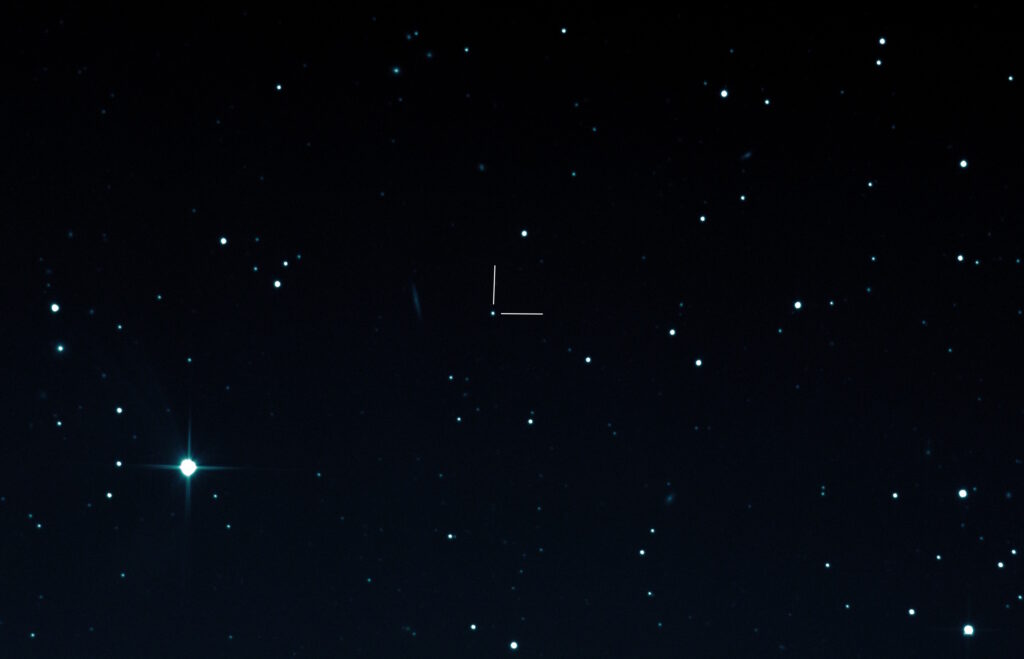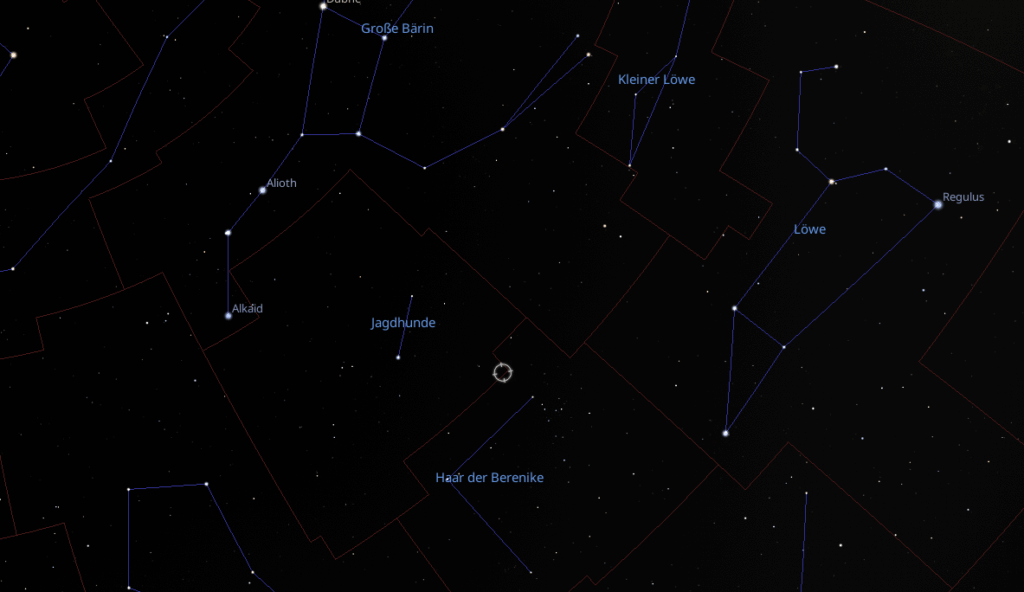– A photo from my garden in Osnabrück –
Article by Dr. Gerold Holtkamp, May 9, 2025
On April 26, 2025, I captured an image showing an area on the border between the constellation Canes Venatici and the constellation Coma Berenices. It's probably the most unspectacular image I've ever taken. Among the recognizable stars and objects, however, is my personal record holder: the quasar TON 618 (RX J1228.4+3128)! It's a true monster in terms of mass and absolute luminosity, because the innermost core of TON 618 is a so-called supermassive black hole.
The very strong broadening of its spectral lines (measured, for example, by Hβ) suggests an extremely high speed of the glowing gas falling toward the black hole.* Velocities of over 10,000 km/s have been reported [1]. With a resulting estimated mass of over 60 billion solar masses, the black hole at the center of TON 618 is one of the largest black holes discovered to date.
From the distance (time of travel of light) of 10.8 billion years determined via the redshift of z = 2.22 and the apparent brightness of 15.87 mag (vis), it is estimated that TON 618 shines over 140 trillion times as bright as the sun, making it one of the brightest known objects in the universe [2].
The diameter of the so-called event horizon of TON 618 measures approximately 390 billion kilometers. This makes the black hole of TON 618 about 40 times the diameter of our solar system [3]!
To get this “spectacular” shot, I used the following technique in my garden near the city in Osnabrück:
Teleskop: Newton 250/1200
Camera: QHY268M
Imaging:
Luminance 42 x 180 s
Red, Green, Blue 14 x 180 s each
This results in a total exposure time of 4.2 hours.
I edited the photo with AstroArt and Paintnet.

To the left of the quasar, the galaxy UGC 7604, seen from the edge, is faintly visible. With a redshift of z = 0.023 [4] and the resulting calculated light travel time of about 300 million years [5] compared to TON 618, it is almost our “neighbor”.

Right ascension 12h 28m 25s | Declination +31° 28′ 38″
Source: Stellarium
___________________________________________________________
*
The so-called Doppler effect causes the wavelength of light emitted by a moving object to change. As the object approaches us, the wavelength is shortened; as it moves away from us, the wavelength is increased. In the turbulent gas of a quasar's accretion disk, both cases occur, so the respective emission lines of the different gases appear broader.
___________________________________________________________
[1] O. Shemmer et al, THE ASTROPHYSICAL JOURNAL, 614:???–???, 2004 OCTOBER 10, https://arxiv.org/pdf/astro-ph/0406559
[2] NASA/IPAC Extragalactic Database, https://ned.ipac.caltech.edu/cgi-bin/nph-objsearch?objname=RX%20J1228.4%2B3128&extend=no&out_csys=Equatorial&out_equinox=J2000.0&obj_sort=RA+or+Longitude&of=pre_text&zv_breaker=30000.0&list_limit=5&img_stamp=YES
[3] https://www.guinnessworldrecords.com/world-records/76251-heaviest-black-hole?utm_source=chatgpt.com
[4]https://simbad.u-strasbg.fr/simbad/sim-id?Ident=UGC+7604&NbIdent=1&Radius=2&Radius.unit=arcmin&submit=submit+id
[5] https://astro.goblack.de/Theorie/t_tools.html